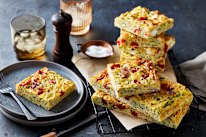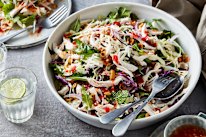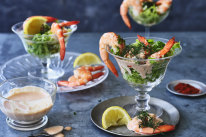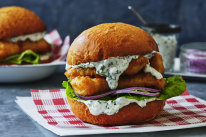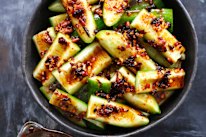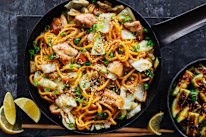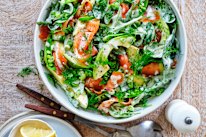How to cook Adam Liaw’s perfect slow-roasted lamb shoulder with gravy and fresh mint sauce
This recipe features in Adam Liaw’s 10 dishes you need to master.
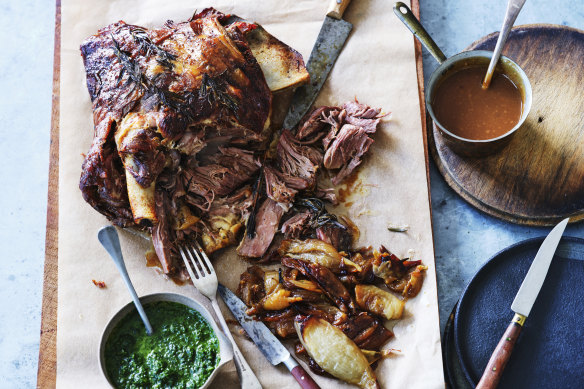
Over the past decade or so, lamb shoulder has replaced the leg as the Aussie roast of choice, and it’s no wonder. It’s a forgiving cut that’s delicious served medium-rare through to falling-off-the-bone (see tips). It’s perfect when balanced with a rich gravy and acidic mint sauce.
Ingredients
3 brown onions, peeled and quartered
1.8kg lamb shoulder, bone-in
salt and pepper, to season
4 sprigs rosemary
2 tbsp olive oil
2 tbsp plain flour
125ml red or white wine
500ml chicken stock
1 tbsp dark soy sauce
1 tbsp instant gravy powder (such as Gravox)
1 tsp red wine vinegar
MODERN MINT SAUCE
2 cups loosely packed mint leaves, finely chopped
2 tbsp sugar
1 tbsp fish sauce (optional)
½ cup white vinegar
salt, to season
Method
Step 1
For the mint sauce, combine all the ingredients together and mix to dissolve the sugar and salt. Dilute with a little water if needed. Taste and adjust seasoning.
Step 2
Heat your oven to 180C fan-forced (200C conventional). Place the onions in the base of a large lidded casserole dish. Season the lamb well with salt and pepper and place on top of the onions. Add a cup of water to the base of the dish, place the rosemary sprigs on top of the lamb, drizzle with the olive oil and place the lid on the dish. Roast the lamb, covered, for 2.5 hours, then uncovered for a further 1.5-2 hours until is nicely browned and very tender. (If you prefer your lamb medium-rare, roast it uncovered only for 90 minutes until the internal temperature reaches 60C.)
Step 3
Remove the lamb from the oven. Place on a large platter and rest in a warm place. Pour any liquid from the base of the casserole dish into a measuring jug. This will likely be a mix of oil and roasting juices. If you want to separate the oil from the juices, you can either spoon off the oil as a liquid, or place the jug in the fridge to solidify the oil.
Step 4
Return the casserole dish to the heat and add 2 tbsp of fat back to the dish. Add the flour and stir to mix with the fat. Cook for about 3 minutes until the flour starts to brown. Add the wine and scrape up any residue from the base of the dish. Add the stock a little at a time, stirring to remove lumps before adding more stock. Stir through the dark soy sauce and instant gravy powder. Taste and adjust the seasoning and consistency, then remove from the heat and stir through the red wine vinegar. Serve the lamb on top of the onions, with the gravy and mint sauce on the side.
Tips
How long?
The age-old question of how long to cook a roast is a lot less complicated than it may seem.
Any quick Google search reveals wildly different timings, tables and formulae all geared towards achieving a perfect result. Even the most reputable of sources seem to be confused, and this in turn confuses all of us, which is why cooking lamb shoulders to “falling off the bone” (as in this recipe) has become a default position. There’s nothing wrong with that, but if you want to be able to figure out once and for all how long to cook a roast, it’s as simple as checking the temperature.
These days a probe thermometer costs less than the price of a single roast, can be used for all cuts and types of meat, and will avoid guesswork and online misinformation around cooking times forever.
If you want tender roast chickens, pink roast beef and medium-rare lamb every time, the answer is right there. Every type of meat, cut, shape and size will have a different entry in a pages-long cooking table, but they all end up in the same place temperature-wise.
I don’t even mess around with temperature. I roast most large meat cuts at 180C fan-forced, and start to check the internal temperature with a thermometer after about 20 minutes’ cooking time per 500g. So for a 2kg roast of any kind, that’s about an hour and 20 minutes. Exceptions to this would be tenderloin (which I hardly ever roast anyway) and chicken, which I roast hotter and faster to get maximum browning on the skin.
Remove the roast from the oven when the internal temperature is about 50C and it will be rare, about 55C will be medium-rare, and about 60C will be medium. That’s it.
Gravy
The difference between a gravy and a pan jus (which we’ll cover in another recipe) is that a gravy is usually thickened with starch, while a jus is reduced. Gravy is a must-have with almost any roast, and the process of making it is quite simple.
After cooking the meat, pour most of the fat out of the pan and stir in flour to make a roux. Try to cook the roux until it’s brown without burning the fond (browned bits) in the pan. Add water or, better yet, an umami liquid (such as stock, wine, or both) a little at a time and scrape up as much of the fond from the base of the pan as you can, cooking it until the gravy is thickened before straining and adjusting the seasoning.
Salt is usually needed, but a bit of sweetness and sourness from a touch of vinegar (or tomato sauce) also helps. I like to add a little more umami in the form of soy sauce or gravy powder as well. Now if you think I’ve just mentioned “umami” a few too many times and you’re a little confused, read on.
Taste and tannin
We have precisely five tastes – salty, sweet, sour, bitter and umami (savouriness) – and these are fundamental to a good dish. Umami isn’t a buzzword. It’s a literal, scientific taste that corresponds to receptors in your mouth. It’s savoury – if you think of licking a stock cube, that’s how it tastes.
A roasted lamb shoulder and its gravy are salty and umami, the long-roasted onions in this recipe provide sweetness and more umami, and so the dish needs a little sourness to round it out, hence the vinegar in the gravy and in the mint sauce. I spike the mint sauce with fish sauce – not for fishiness, but to layer in a little extra umami.
As important as balancing taste is the issue of tannin. Rich food gives us a luxurious mouthfeel, and tannins remove proline-rich lubricating proteins from our saliva to leave the mouth feeling “dry”. This balance between a rich mouthfeel and palate-cleansing “dryness” is behind so many of our favourite rich food/tannic drink combinations like steak and red wine, cake (or dumplings) and tea, and burgers and soft drinks.
So it should not surprise you that lamb, which can be a little on the rich and fatty side, is often paired with our most tannic herbs – mint and rosemary – or tannic spices such as cinnamon, cumin and clove.
You don’t need to learn all the science around food, but knowing that lamb pairs well with rosemary and/or mint, or can be happily roasted with cumin or cinnamon is a good start. A nicely tannic red wine completes the balance.
Appears in these collections
- 20 of last winter’s most-loved recipes to cook again this one
- 11 fall-apart lamb shoulder recipes (plus the perfect roast potatoes) for your Easter feast
- Keep calm and curry on: Good Food’s 50 most popular recipes of 2023
- All killer, no filler: Good Food’s 50 most popular recipes of 2023 (so far)
- Good Food’s 10 most popular recipes of autumn (starring RecipeTin Eats’ record-breaking chicken curry)
The best recipes from Australia's leading chefs straight to your inbox.
Sign up
